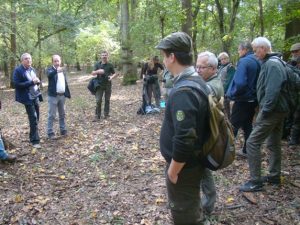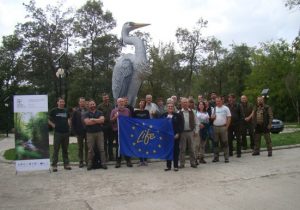Gergely Janik Head of scientific department assistant and Dániel Andrési sylvicultural presenter from KEFAG Zrt. took part on a study tour in Romania which was organised within the LIFEinFORESTS (LIFE13 INF/HU/001163) project. The aim of this trip was the networking. The event took place from 26 – 28th September in 2017.
We took part on a study tour in Romania within the LIFEinFORESTS project coordinated by Kiskunság National Park Directorate. On the first day we listened to some professional presentations in connection with the local nature reservations and the Kiskunság National Park Directorate was also introduced.
On the second day we went for a roam to the flood-basin forest nearby Arad.
On the third day we walk in the flood – basin forest in the vicinity of Csanád.
Experiences:
After becoming a member of the EU, in Romania 29 national and natural parks were created which are suitable for the conservation of natural values. Apart form these parks there are many nature reservations. Only 6,3 % of the Romanian territory is protected this way. In Arad county 30 % of the area is protected. In the national and nature parks 15 people are employed on average.
The Maros flood-basin Natur Park was created in 2005 within the frames of the Phare program.
Number of employees:12 people.
Annual budget: 150000 EUR
Area: 17500 ha, out of which 7300 ha is forest.
45% of the forests belong to the state, 40% of them is private property and the rest belong to the municipal council.
They have softwood and hardwood woodlands.
The area of the park has been shaped by the river Maros, which has had a significant effect on the area for 250 years. There is an orthodox abbey in the park and because of the closeness of Arad there are many visitors. There are many tour lanes here for hikers and cyclists and canoe trips are also organised. 88 km of the river Maros is flowing through the territory of the national park. 30.000 people visit the park yearly.
In the area there are 44 protected bird species. The most important are the sand martin, the bee-eater, the European – roller, the kingfisher, the grey heron and the great egret. On the seed area there are several raptores such as the fish eagle.
In Romania only private individuals can get compensation for Natura 2000 territories in the form of tax allowance.
In Romania the national parks are supervised by the „Supervising Office of the Reserved Areas” and the Environmental Protection Ministry.
The environmental protection results and problem of the Maros flood-basin Natur park
- Helping the succession of the hardwoods in the softwood woodland on the edge of Csanád county is successful
- On 75% of the whole are A and FD plantations can be found.
- The stealing of the wood is a serious problem.
- Due to the maintenance of the forest there are not many dead trees.
- Invasive species make the agriculture more difficult: mainly the maple ash and the indigo and the hackberries on the edge of Csanád.
- The devastation of the elm trees has caused serious problems for the silviculture and forestry workers
(Summery is based on Dániel Andrési’s report; photos by Dániel Andrési)
